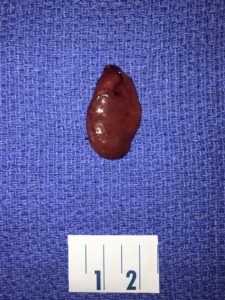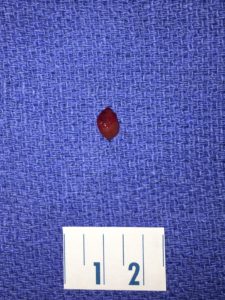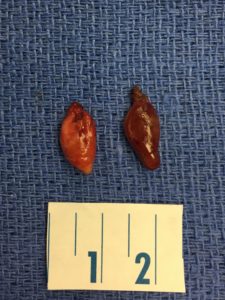The parathyroid glands regulate the body’s calcium level through the production of parathyroid hormone (PTH). The parathyroid glands are located near the thyroid on both sides of the neck, and there are four of them. These glands can develop a benign growth called an adenoma which produces too much PTH and causes a condition called primary hyperparathyroidism. The first sign of this condition is an elevated blood calcium level, but hyperparathyroidism can lead to kidney stones, osteoporosis, depression, and bone pain.
The diagnosis of hyperparathyroidism is made through blood work alone. Imaging studies such as ultrasound and sestamibi scanning (nuclear medicine test) are only used to assist with surgical planning. Parathyroid surgery is tricky because neither the degree of calcium elevation nor the size of the abnormal gland or glands correlates with the disease severity. Larger adenomas are easier to identify before surgery with imaging studies, but with parathyroid adenomas, size doesn’t matter.

This is a picture of a typical appearing parathyroid adenoma. The ruler beneath the adenoma is 2.5 cm in length (the size of the incision). This adenoma was removed from a 33 year-old woman who did not have any symptoms, yet her calcium was very high (11.6). Because of its size, it was easily seen before surgery with ultrasound and sestamibi scans.

Here is a picture of a very small parathyroid adenoma. Again, the ruler is 2.5 cm in length. This adenoma was removed from a 44 year-old man who had numerous kidney stones (requiring lithotripsy on at least 5-6 occasions), bone pain, memory problems, and fatigue. His calcium level before surgery was only 10.6, despite the severity of his symptoms. Since his adenoma was so small, it didn’t show up on any scans before surgery.

About 15% of the time, there is not one but two abnormal parathyroid glands. Often times, the larger of the two will show up on scans, but the smaller one usually does not. Both need to be removed to cure the disease, and the optimal time to do so is in the initial operation. All four glands can be evaluated through the same one inch incision. This is done routinely on every case, and takes less than an hour to perform.
Surgery is the only definitive treatment for primary hyperparathyroidism, and minimally invasive techniques have made parathyroidectomy an outpatient procedure.
